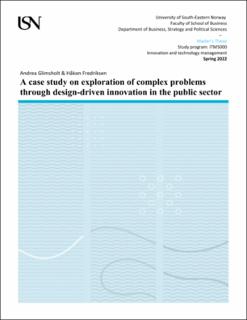| dc.description.abstract | In this case study, we have examined how complex problems are explored through design-driven innovation in the public sector. The project is linked to a highly ambitious program aiming to transform the way money collection is handled. We have linked the design-driven process to findings in the project to give context to the challenges and opportunities the project experience throughout the diagnosis phase of the project. This case study is conducted in the diagnosis phase of the project ‘Cross-sectoral management and development of coherent services - how do we succeed?’ owned by the Norwegian Tax Administration. The project is trying to find a solution on how the program can succeed with cross-sectorial management and development of coherent services
The research question:
How are complex problems explored through design-driven innovation in the public sector?
To answer the research question, we conducted a single-case study with a qualitative approach. Multiple observations were conducted throughout the exploration phase and interviewed seven highly relevant people from the project. Three people from the client side, two from the Norwegian Tax Administration and one from NAV. Three people from the supplier side, Rambøll Consulting, Halogen and Agenda Kaupang. Additionally, one person from Design and Architecture Norway (DOGA).
In the public sector, design-driven innovation is not a frequently used method to explore complex problems. The program needs to find a way to manage transformational activities. There is no common understanding of transformation in relation to the program or how transformation will impact the program. A common understanding of the problem context is necessary before involving end-users to be certain that the right problems are explored. Furthermore, complementary expertise between the involved actors is important when gathering information and analysing the problem area. Visualisation is used as a tool to facilitate cross-disciplinary conversations, and in discussions where the problem is difficult to talk about. The analysis of the data material resulted in a model with four main topics that are important when exploring complex problems through design-driven innovation in the public sector: Problem context, the collaboration between actors, visualisation, and the search for knowledge and perspectives.
Keywords: Innovation, Design-driven innovation, Open innovation, Exploration, Complex problems, public sector, Modernisation, Transformation, StimuLab | |
